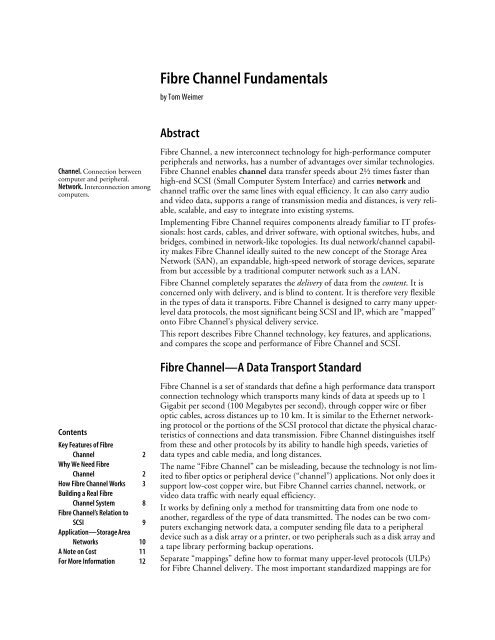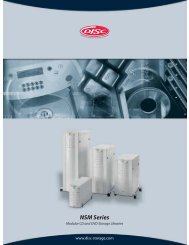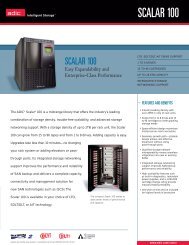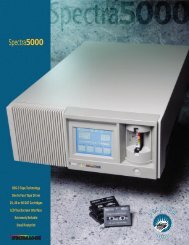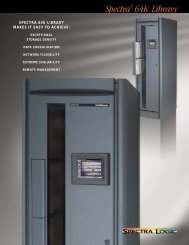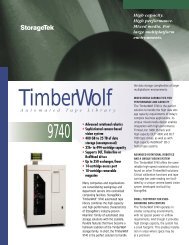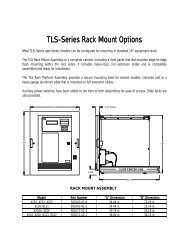Fibre Channel Fundamentals (PDF) - Unylogix Technologies Inc.
Fibre Channel Fundamentals (PDF) - Unylogix Technologies Inc.
Fibre Channel Fundamentals (PDF) - Unylogix Technologies Inc.
You also want an ePaper? Increase the reach of your titles
YUMPU automatically turns print PDFs into web optimized ePapers that Google loves.
<strong>Fibre</strong> <strong>Channel</strong> <strong>Fundamentals</strong>by Tom WeimerAbstract<strong>Channel</strong>. Connection betweencomputer and peripheral.Network. Interconnection amongcomputers.<strong>Fibre</strong> <strong>Channel</strong>, a new interconnect technology for high-performance computerperipherals and networks, has a number of advantages over similar technologies.<strong>Fibre</strong> <strong>Channel</strong> enables channel data transfer speeds about 2½ times faster thanhigh-end SCSI (Small Computer System Interface) and carries network andchannel traffic over the same lines with equal efficiency. It can also carry audioand video data, supports a range of transmission media and distances, is very reliable,scalable, and easy to integrate into existing systems.Implementing <strong>Fibre</strong> <strong>Channel</strong> requires components already familiar to IT professionals:host cards, cables, and driver software, with optional switches, hubs, andbridges, combined in network-like topologies. Its dual network/channel capabilitymakes <strong>Fibre</strong> <strong>Channel</strong> ideally suited to the new concept of the Storage AreaNetwork (SAN), an expandable, high-speed network of storage devices, separatefrom but accessible by a traditional computer network such as a LAN.<strong>Fibre</strong> <strong>Channel</strong> completely separates the delivery of data from the content. It isconcerned only with delivery, and is blind to content. It is therefore very flexiblein the types of data it transports. <strong>Fibre</strong> <strong>Channel</strong> is designed to carry many upperleveldata protocols, the most significant being SCSI and IP, which are “mapped”onto <strong>Fibre</strong> <strong>Channel</strong>’s physical delivery service.This report describes <strong>Fibre</strong> <strong>Channel</strong> technology, key features, and applications,and compares the scope and performance of <strong>Fibre</strong> <strong>Channel</strong> and SCSI.<strong>Fibre</strong> <strong>Channel</strong>—A Data Transport StandardContentsKey Features of <strong>Fibre</strong><strong>Channel</strong> 2Why We Need <strong>Fibre</strong><strong>Channel</strong> 2How <strong>Fibre</strong> <strong>Channel</strong> Works 3Building a Real <strong>Fibre</strong><strong>Channel</strong> System 8<strong>Fibre</strong> <strong>Channel</strong>’s Relation toSCSI 9Application—Storage AreaNetworks 10A Note on Cost 11For More Information 12<strong>Fibre</strong> <strong>Channel</strong> is a set of standards that define a high performance data transportconnection technology which transports many kinds of data at speeds up to 1Gigabit per second (100 Megabytes per second), through copper wire or fiberoptic cables, across distances up to 10 km. It is similar to the Ethernet networkingprotocol or the portions of the SCSI protocol that dictate the physical characteristicsof connections and data transmission. <strong>Fibre</strong> <strong>Channel</strong> distinguishes itselffrom these and other protocols by its ability to handle high speeds, varieties ofdata types and cable media, and long distances.The name “<strong>Fibre</strong> <strong>Channel</strong>” can be misleading, because the technology is not limitedto fiber optics or peripheral device (“channel”) applications. Not only does itsupport low-cost copper wire, but <strong>Fibre</strong> <strong>Channel</strong> carries channel, network, orvideo data traffic with nearly equal efficiency.It works by defining only a method for transmitting data from one node toanother, regardless of the type of data transmitted. The nodes can be two computersexchanging network data, a computer sending file data to a peripheraldevice such as a disk array or a printer, or two peripherals such as a disk array anda tape library performing backup operations.Separate “mappings” define how to format many upper-level protocols (ULPs)for <strong>Fibre</strong> <strong>Channel</strong> delivery. The most important standardized mappings are for
<strong>Fibre</strong> <strong>Channel</strong> <strong>Fundamentals</strong> How <strong>Fibre</strong> <strong>Channel</strong> Works 3dards Institute (ANSI) formed a group of committees whose objective was to design ahigh-performance I/O protocol that:• Transfers large amounts of data at very high speeds• Is independent of the data transmitted, so it carries both network and channeltypes of traffic, and• Supports a variety of physical carrying media, such as fiber optics and copper wireTo accomplish all this, the standards group needed an interconnect technology thatwas:• Serial—to overcome the speed, distance, and reliability limitations inherent in parallelprotocols like SCSI• Asynchronous—to handle both network and channel traffic in the same protocolHow <strong>Fibre</strong> <strong>Channel</strong> Works<strong>Fibre</strong> <strong>Channel</strong> standards specify the physical characteristics of the cables, connectors,and signals that link devices. They also describe three general topologies for connectingdevices. Finally, since <strong>Fibre</strong> <strong>Channel</strong> only provides a data transport mechanism,they define how to map upper-level protocols such as SCSI and IP to the <strong>Fibre</strong> <strong>Channel</strong>data format.Link. A connection between twodevices, regardless of the connectingmedium.Port. The <strong>Fibre</strong> <strong>Channel</strong> interfaceon a device, with separate“transmit” and “receive” connections.Physical Components—Cables, Ports, and Links<strong>Fibre</strong> <strong>Channel</strong> carries data over many types of electrical and optical cable. In manycases, this permits converting cables already installed for other interconnects into<strong>Fibre</strong> <strong>Channel</strong> cables.A connection between two devices is called a link. Cables connect to ports on thedevices to form a link. Each port has two connections, one dedicated to transmittingdata, the other to receiving. In a simple link between two devices, A and B, one cableconnects the transmit side of the port on device A with the receive side of the port ondevice B, and another cable connects device B’s transmit side with device A’s receive,as shown in the following diagram.Device APortDevice BPortTransmitReceiveTransmitReceiveIllustration of a connection between two <strong>Fibre</strong> <strong>Channel</strong> nodes(point-to-point topology shown)Several kinds of acceptable copper wire and multi-mode or single-mode fiber opticcables have been approved for <strong>Fibre</strong> <strong>Channel</strong>. Ports are specific to one kind of cableor signal, but adapters exist to convert from one signal type to another. The table
3 3 /FAE CENTRO UNIVERSITÁRIOConvocaçãoPSICOLOGIA - CAMPUS CENTRO I - CURITIBATurno : NOTURNO964820 ANALISY OLIVEIRA MULLER964856 KAMILLA PELLIZZARI964819 LARISSA DE MELO SCHROEDER964794 LETICIA WEIGERT DE NUNES COELHO
6 <strong>Fibre</strong> <strong>Channel</strong> <strong>Fundamentals</strong> How <strong>Fibre</strong> <strong>Channel</strong> Worksthis. In a dual loop, each device has two separate <strong>Fibre</strong> <strong>Channel</strong> ports, and each portattaches to a separate loop. If one loop goes down because of a cable or hub malfunction,the devices are still available through the second loop. Each loop may or maynot go through a hub. The diagram below illustrates a dual loop configuration, whereone loop is routed through a hub.Disk arrayServerHubWorkstationTape libraryDual arbitrated loop topology, with one loop routed through a hubFabric. A switched topology providingfull-speed simultaneousconnections for up to 16 milliondevices.The four devices in this topology would each have two separate <strong>Fibre</strong> <strong>Channel</strong> ports.Many <strong>Fibre</strong> <strong>Channel</strong> storage devices now include two ports to support dual loop configurations.Although in this illustration each device is attached to both loops, adevice could be on just one loop, so if a device has only one <strong>Fibre</strong> <strong>Channel</strong> port, itcan be part of a single loop while the other devices are on both loops.The configuration possibilities of arbitrated loop are almost endless and can be tailoredto virtually any need short of a large network. It is becoming an especially popularmethod for mass data storage because of its flexibility, its ability to provide manylevels of redundancy, and the ease with which new capacity can be added. Its mostimportant and revolutionary application has been in storage area networking (SAN),which is discussed in more detail below.The most powerful <strong>Fibre</strong> <strong>Channel</strong> topology is the fabric, or switched fabric. In additionto ports on each device, a fabric requires one or more hardware switches, makingit more costly to implement than point-to-point or arbitrated loop. However, itboosts connectivity to a logical limit of 16 million devices per fabric, and unlike arbitratedloop, each fabric connection has the full speed of a point-to-point connection.A fabric works similarly to a phone system. One device “dials up” another by supplyingits fabric address. The switching hardware then creates a direct connectionbetween the two devices, which stays open until the devices terminate the connec-
8 <strong>Fibre</strong> <strong>Channel</strong> <strong>Fundamentals</strong> Building a Real <strong>Fibre</strong> <strong>Channel</strong> SystemUpper-Level Protocol Mapping<strong>Fibre</strong> <strong>Channel</strong> does not substitute for any protocol which defines how to format orinterpret data in a particular way to control devices, such as IP (Internet Protocol) orthe higher levels of SCSI. It defines only the physical characteristics of interconnectingdevices, how to connect them, address them, and how to package data for transmission.To insure device interoperability, standards have been developed to map some ofthese higher-level protocols to a format that <strong>Fibre</strong> <strong>Channel</strong> can transmit. For example,one protocol defines how to translate SCSI command descriptors, which wouldnormally be sent in parallel, into serial <strong>Fibre</strong> <strong>Channel</strong> format, and back to parallelSCSI when they are received by the target device. The following network and channelprotocol mappings have been specified or proposed:• Small Computer System Interface (SCSI)• Intelligent Peripheral Interface (IPI)• High Performance Parallel Interface (HIPPI) Framing Protocol• Internet Protocol (IP)• Link Encapsulation (FC-LE) using International Standard (IS) 8802.2 (network)• Single Byte Command Code Set Mapping (SBCCS) to implement ESCON andblock multiplex interfaces• Audio Video Fast File Transfer• Audio Video Real Time Stream Transfer• AvionicsProprietary mappings are also possible but not covered by the standards.Building a Real <strong>Fibre</strong> <strong>Channel</strong> SystemThe elements of a <strong>Fibre</strong> <strong>Channel</strong> system are much the same as for other commoninterconnect methods, whether network or I/O channel. The basic components arehost bus adapter (HBA) cards, cables, and software drivers. The HBA is equivalent toa SCSI host adapter card or a network interface card (NIC). The process for connectinga <strong>Fibre</strong> <strong>Channel</strong> device, such as a disk or tape library, to a host computer in a simplepoint-to-point link would be:• Install the HBA in the host computer• Connect cables to the <strong>Fibre</strong> <strong>Channel</strong> port on the HBA and the port on the device• Install driver software on the host computerTo network several computers or devices, you would need a host adapter for eachcomputer. You can add other products to expand the capability of a <strong>Fibre</strong> <strong>Channel</strong>system:• hubs or switches to support loop or fabric topologies• <strong>Fibre</strong>-<strong>Channel</strong>-to-SCSI or -Ethernet bridges, to connect legacy devices and networksto <strong>Fibre</strong> <strong>Channel</strong> systems• Extenders or repeaters to enable longer fiber optic or electrical cable lengthsThe type of host bus adapter you need depends on the bus type of your host computer.PCI bus <strong>Fibre</strong> <strong>Channel</strong> host adapters are widely available. HBAs are also availablefor other common bus types such as SBus, EISA, MCA, PMC and VME. SomeHBAs can support any <strong>Fibre</strong> <strong>Channel</strong> topology, and some can support only certaintopologies.Driver software typically comes with the HBA and is written for specific operatingsystems, so it is important to make sure an HBA vendor has a driver for your operatingsystem when looking for a card. Driver software exists for most popular operating
<strong>Fibre</strong> <strong>Channel</strong> <strong>Fundamentals</strong> <strong>Fibre</strong> <strong>Channel</strong>’s Relation to SCSI 9systems, such as Windows 95/NT, Sun Solaris, HP-UX, IBM AIX, Sequent DYNIX/ptx, SGI IRIX, SCO Unixware, and Macintosh. Almost all HBA vendors have driversfor Windows 95/NT, and many have them for Solaris, but finding a card forother operating systems might require some research.Although there are some fiber-optic-ready host adapters, most HBAs come with anelectrical DB-9 or HSSD serial connector, so using them with fiber optic cablesrequires a Media Interface Adapter (MIA) to convert between electrical and opticalsignals. MIAs can also be used to convert electrical <strong>Fibre</strong> <strong>Channel</strong> devices for use withfiber optics.<strong>Fibre</strong> <strong>Channel</strong>’s Relation to SCSIIt is important to recognize that <strong>Fibre</strong> <strong>Channel</strong> does not replace SCSI. SCSI is anexpansive standard which defines physical connection and transmission methods, aswell as high-level command and message sets for peripheral devices. <strong>Fibre</strong> <strong>Channel</strong>covers only the physical aspects of connecting devices and transmitting data signals. Itcompletely separates the delivery of data from the content. SCSI, in contrast, can bethought of as two separate protocols, a lower-level protocol which covers physicalconnections and upper-level protocol which defines a command and messaging systemfor a wide range of peripheral device types. The figure below illustrates the functionalsimilarities and differences between SCSI and <strong>Fibre</strong> <strong>Channel</strong>.Defines upper-level commandand message formatsDefines mapping between physicaland upper-level protocol(s)Defines device addressing anddata routing methodsDefines physical cable, connector,and signal characteristics<strong>Fibre</strong> <strong>Channel</strong>SCSIHardware-based Software-basedComparing the scope of <strong>Fibre</strong> <strong>Channel</strong> and SCSI protocolsUpper-level protocols like SCSI are laid over <strong>Fibre</strong> <strong>Channel</strong>’s physical transport services.Because <strong>Fibre</strong> <strong>Channel</strong> and SCSI’s physical layer use different addressing andcontrol methods, SCSI data has to be modified to a format that <strong>Fibre</strong> <strong>Channel</strong> candeliver. This process is called “mapping.” <strong>Fibre</strong> <strong>Channel</strong> defines standard mappingsfor SCSI and many other upper-level protocols. When mapped SCSI data arrives atits destination, it is then remapped back to SCSI format.
10 <strong>Fibre</strong> <strong>Channel</strong> <strong>Fundamentals</strong> Application—Storage Area NetworksParallel. Sending multiple bits ofdata at a time by using multiplewires in a connection.The upper-level commands and message system of the SCSI protocol remain themost popular way to control peripheral devices. Device manufacturers and softwaredevelopers have invested a lot of time and money in programming for the SCSI standard,and the number of SCSI devices currently in use is countless. With <strong>Fibre</strong> <strong>Channel</strong>mapping and <strong>Fibre</strong>-<strong>Channel</strong>-to-SCSI bridges, SCSI devices and technologyretain their functionality but can now take advantage of the superior data transferspeed, reliability, and flexibility that <strong>Fibre</strong> <strong>Channel</strong> provides.Why go to all this trouble of mapping, remapping, and bridging? Why not just usestandard SCSI cables and connections? Because <strong>Fibre</strong> <strong>Channel</strong> provides faster, morereliable data transport to more devices over greater distances than SCSI connections.SCSI’s physical transmission speed, distance, and scalability are limited by its parallelnature. The many electrical wires in a SCSI cable generate interference which hamperssignal reliability. This interference gets worse at higher data transfer rates, longercable lengths, and when wires are added to boost parallel capacity. <strong>Fibre</strong> <strong>Channel</strong>does not have these problems because it is a serial technology. The following tablecompares the performance characteristics of <strong>Fibre</strong> <strong>Channel</strong> and physical SCSI.Comparison of <strong>Fibre</strong> <strong>Channel</strong> and SCSI Data Transfer<strong>Fibre</strong> <strong>Channel</strong>Arbitrated LoopUltra SCSIUltra/Wide SCSIClock speed 1,062.5 MHz 20 MHz 20 MHzBits/cycle 1 8 (1 byte) 16 (2 bytes)Data transfer speed 100 MB/sec 20 MB/sec 40 MB/secPlannedimprovements200 MB/sec and400 MB/sec40 MB/sec and80 MB/sec80 MB/sec and160 MB/secDistance coveredUp to 10 km betweendevices connected byfiber optics, 30 m forcopper wire25 m for entire differentialSCSI bus, 12 m forlow-voltage differential25 m for entire differentialSCSI bus, 12 m forlow-voltage differentialMaximum Numberof devices126 8 16Application—Storage Area NetworksAlthough <strong>Fibre</strong> <strong>Channel</strong> defines a common interconnect method for all types of datatraffic, including network and peripheral device communications, most developmentfor <strong>Fibre</strong> <strong>Channel</strong> technology right now is for data storage devices. One reason forthis is that the early development of <strong>Fibre</strong>-<strong>Channel</strong>-to-SCSI bridges makes it possibleto add <strong>Fibre</strong> <strong>Channel</strong> storage devices to a system while maintaining compatibilitywith older SCSI storage devices. Bridges for <strong>Fibre</strong>-<strong>Channel</strong>-to-Ethernet compatibilityhave only recently become available.The networking capacity of <strong>Fibre</strong> <strong>Channel</strong> has led to a new concept in network datastorage: the Storage Area Network (SAN). The high performance network capacity of
<strong>Fibre</strong> <strong>Channel</strong> <strong>Fundamentals</strong> A Note on Cost 11<strong>Fibre</strong> <strong>Channel</strong> can combine with its peripheral I/O nature to create a network ofstorage devices, separate from the common LAN, with one or more servers acting as agateway to storage access.Storage Area Network (SAN)Traditional LANA SAN provides high-speed data storage and retrieval which is scalable and highlyavailable. Another advantage of SANs is that data transfer between storage devicescan take place without clogging the LAN. This greatly simplifies issues such as mirroringand backup. Scheduling backups over a network has become increasingly difficultas enterprise-wide applications demand virtually uninterrupted access to datastorage. With a storage-dedicated network, tape backups can be run almost anytimewith little impact on network performance.The SAN concept also provides reliable data access. With a dual arbitrated loop, theSAN can be connected to two servers, providing redundant access to all storage incase the one server goes down.A Note on CostExample of a Storage Area Network (SAN)It is difficult to compare the cost of implementing <strong>Fibre</strong> <strong>Channel</strong> to other existingtechnologies, because it offers a set of features not available from any other data transportservice. Many aspects of <strong>Fibre</strong> <strong>Channel</strong> technology, such as its serial nature, abilityto carry network and channel traffic, speed, and flexibility, make it an inherentlyeconomical technology for high-speed, high-volume applications. <strong>Fibre</strong> <strong>Channel</strong>should be considered for any application that requires a combination of high datathroughput, long transmission distances, low maintenance, and high reliability.Legacy technologies such as SCSI and Ethernet currently enjoy economies of scale,due to their mass popularity, which <strong>Fibre</strong> <strong>Channel</strong> won’t see for a few years yet. As<strong>Fibre</strong> <strong>Channel</strong> gains popularity and more systems adopt it, the prices of <strong>Fibre</strong> <strong>Channel</strong>components will drop dramatically.<strong>Fibre</strong> <strong>Channel</strong> is an ideal technology for gradual integration. Bridges to other technologiesmake it possible to implement <strong>Fibre</strong> <strong>Channel</strong> in stages, where it is mostneeded first, while maintaining links to older technologies. Rather than completelyreplacing entire systems, <strong>Fibre</strong> <strong>Channel</strong> devices can easily be added as older deviceswear out or become obsolete.
12 <strong>Fibre</strong> <strong>Channel</strong> <strong>Fundamentals</strong> For More InformationFor More InformationMuch information on <strong>Fibre</strong> <strong>Channel</strong> is available on the Internet. The following companiesor organizations have websites covering various aspects of <strong>Fibre</strong> <strong>Channel</strong> technology.Most of these sites also contain links to further information on <strong>Fibre</strong> <strong>Channel</strong>technology, products, news, and frequently asked questions (like why “<strong>Fibre</strong>” isspelled “-re” instead of “-er”). The sources are listed approximately by the amount ofgeneral <strong>Fibre</strong> <strong>Channel</strong> information they contain. Sites further down on the list focusmore on specific <strong>Fibre</strong> <strong>Channel</strong> products or applications.• The <strong>Fibre</strong> <strong>Channel</strong> Association (FCA)Industry associationhttp://www.fibrechannel.com/• The <strong>Fibre</strong> <strong>Channel</strong> Loop Community (FCLC)Industry associationhttp://www.fcloop.org/• Gadzoox Networks<strong>Fibre</strong> <strong>Channel</strong> hubs and switches, emphasis on storage networkinghttp://www.gadzoox.com/• Crossroads Systems<strong>Fibre</strong>-<strong>Channel</strong>-to-SCSI bridges and routershttp://www.crossroads.com/• Emulex Corporation<strong>Fibre</strong> <strong>Channel</strong> hubs and host adaptershttp://www.emulex.com/fc/• Ancor Communications<strong>Fibre</strong> <strong>Channel</strong> switches and host adaptershttp://www.ancor.com/For more information on our <strong>Fibre</strong> <strong>Channel</strong> solutions, please contact us:Tel: (514) 253-5200email: info@unylogix.com


